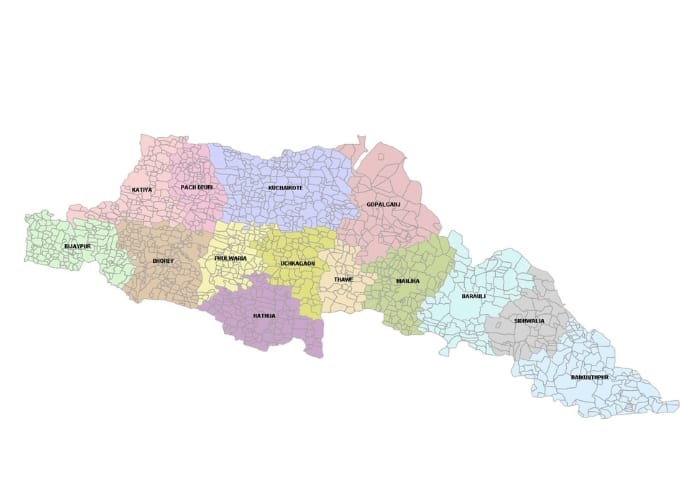About Gopalganj, Bihar
Gopalganj, a district in the northwestern region of Bihar, holds historical significance and a unique identity. It became an independent district on October 2, 1973, marking the day as its official foundation day. Prior to attaining district status, Gopalganj was a small town functioning as a subdivision of the larger Saran district. Since its establishment as a separate administrative entity, Gopalganj has experienced growth and development, emerging as an essential part of Bihar’s governance and infrastructure.


Historical Background and Establishment
Before achieving the status of an independent district, Gopalganj was a part of the historical Saran district, which was one of the oldest administrative divisions in Bihar. Saran district had extensive jurisdiction, encompassing several towns and subdivisions, including present-day Gopalganj. However, due to administrative and governance requirements, a decision was made to carve out Gopalganj as a separate district, ensuring better management and development of the region. On October 2, 1973, this vision was realized, and Gopalganj officially came into existence as an independent district. Since then, the district has celebrated October 2nd as its foundation day, commemorating its transition into a distinct administrative unit.
Administrative Structure and Headquarters
The district headquarters of Gopalganj is located in the town of Gopalganj itself. As the central hub of governance and administration, the headquarters houses key government offices, judicial institutions, and civic amenities that serve the region. The district administration ensures the smooth implementation of policies, infrastructure development, and welfare programs aimed at improving the living standards of the residents.
Geographic Location and Boundaries
Gopalganj is strategically positioned in the northwestern part of Bihar, making it an important district in the region. It is a part of the Saran Division, which includes other significant districts of Bihar. The geographical placement of Gopalganj makes it a crucial area for trade, agriculture, and connectivity.
The district shares its borders with several neighboring districts and natural landmarks:
To the North, it is bordered by Chapra District and the Gandak River, a vital waterway in the region that supports irrigation and agriculture.
To the South, Gopalganj is bounded by Siwan District, another important administrative division in Bihar.
To the NorthWest, it shares a border with Deoria District of Uttar Pradesh, providing inter-state connectivity and facilitating trade and commerce between Bihar and Uttar Pradesh.
Cultural and Economic Significance
Gopalganj has a rich cultural heritage, deeply rooted in the traditions of Bihar. The district is home to diverse communities that contribute to its vibrant social and cultural landscape. Festivals, fairs, and local traditions are an integral part of life in Gopalganj, reflecting the region’s deep connection with its historical and religious roots.
Economically, Gopalganj is primarily agrarian, with agriculture being the backbone of its economy. The fertile land of the district supports the cultivation of various crops, including rice, wheat, pulses, and sugarcane. The presence of the Gandak River further enhances the agricultural prospects by providing a reliable source of irrigation.
In recent years, efforts have been made to develop industrial and commercial sectors in the district. Small and medium enterprises (SMEs) have been encouraged, and the local economy has seen gradual diversification. Improved road connectivity and infrastructure projects have played a crucial role in enhancing trade opportunities for local businesses and farmers.
Infrastructure and Development
Since its establishment as a district, Gopalganj has witnessed significant infrastructural growth. Roads, bridges, and transportation facilities have been improved to ensure better connectivity within the district and with neighboring regions. Educational institutions have been established, providing access to quality education for students in the region.
Healthcare facilities in Gopalganj have also seen advancements, with hospitals and health centers being set up to cater to the medical needs of the population. Government initiatives and schemes have played a pivotal role in ensuring that residents have access to essential healthcare services.
Challenges and Future Prospects
Despite its growth and progress, Gopalganj faces several challenges that need to be addressed for its continued development. Issues such as flood management, road infrastructure in rural areas, and employment opportunities for the youth remain key areas of focus for the administration.
Future development plans for Gopalganj include further improvement of its transportation network, establishment of industrial hubs, and promotion of tourism. Given its historical and cultural significance, tourism could emerge as a potential sector for economic growth if properly developed and marketed.
Conclusion
Gopalganj’s journey from being a subdivision of Saran district to becoming an independent district in 1973 is a testament to its historical and administrative significance. With its strategic location, rich cultural heritage, and economic potential, Gopalganj continues to evolve as a vital district in Bihar. As it moves forward, efforts to address its challenges and harness its strengths will be crucial in shaping a prosperous future for the region and its people.

